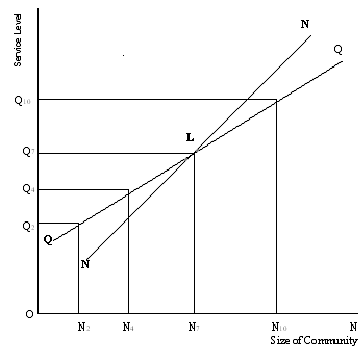Optimal Size of Local Jurisdiction:
The optimal solution can be derived from the above two choices of optimum community size and optimum service level. A combination of these two is shown in Figure. In the figure, the size of the community (N) is measured on the x-axis while the service level (Q) is measured on the vertical axis. The curve N represents the relationship between the community sizes and the cost of service while Q curve explains various optimum service levels for various community sizes. As shown in the diagram, the overall optimal solution is at E, the point of intersection, where the optimal service level of Q7 and the optimal group size being N7.

In this way, multiple fiscal units which vary in size and scope come into existence in a federal structure. While some units may be nation-wide like provision of defense while others will be regional or local (such as law and order and street lighting respectively) Besides the allocation function, the other two important functions of redistribution of Income and Wealth and economic stabilization are to be distributed between the governments. Let us see why and to which level of government these two functions are assigned. Before discussing this aspect, let us know the limitations that exist in relation to the determination of optimum community size.